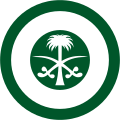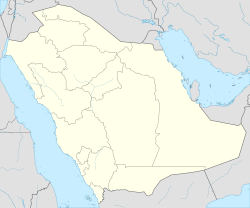History
In 1945, the Royal Terminal and the Passenger Terminal was opened by King Sultan bin Abdulaziz. In 1948, Saudi Arabian Airlines began scheduled operations to and from Riyadh. The first runway, 11/29 was built intended to accommodate Douglas DC-3s. By 1954, passenger numbers had grown to 5,900, which prompted King Saud to establish expansion goals. In 1956, he laid a stone in the foundation, and the expansion began in 1957. When Saudi Arabian Airlines acquired Convair CV-340s, a new longer runway was built in 1956 to accommodate the aircraft, numbered 01/19. [2]
Two new lounges, a reception, and departure hall were completed in 1962, totaling the airport area to 9,300 square meters. [3] At the time, passport services were simple, as reservations for travel was done manually. Passports were also applied to international travelers at a few counters, which caused crowding during the initial years of the airport. In 1965, a runway was built parallel to 11/29, and was designated 11L/29R. It was built to accommodate Boeing 720Bs and 707s. After completion, the eastern end of runway 11/29 was abandoned, and the runway was reserved for light aircraft usage. [2] Riyadh Airport first operated a wide crushed-rock base runway, which measured approximately 1,950 meters long and 45 meters wide. Its facilities included a hangar under construction, administration, smaller buildings, and accommodations for 50 Air Force personnel. There were also grade 1,120 oil available in drums on site. There was a former camp which could accommodate 30 personnel. [4] On July 1958, a new asphalt runway commenced construction, measuring approximately 2743 meters long and 45 meters wide. It consisted of 1.5 meters of asphalt surfacing and a crushed rock end. [5] The rapid urban extension of new neighborhoods began emerging outside Riyadh and towards the airport. By the 1970s, the airport was close to residential neighborhoods, such as the Malaz neighborhood. [6]
Military conversion
On 16 November 1983, King Khalid International Airport was opened, replacing Riyadh International Airport. Subsequently, ownership was transferred to Ministry of Defense, and the airport became a base of the Royal Saudi Air Force. In 2009, the construction of a new runway 15/33 was undertaken by Associated Engineers Company and was completed in 2011. This also included the construction of a highway that went over the airport grounds, and phasing out the former runway 12/30. The project had cost US $200 million. [7] On October 6, 2015, a Royal Decree was issued to rename Riyadh Air Base to King Salman Air Base to honor King Salman bin Abdulaziz upon his ascension to the throne of that year. Additionally, the timing was aligned with the launch of Operation Decisive Storm. [8]
In 2016, the design and production of a drone project implemented by the Prince Sultan Institute for Advanced Technology Research was launched at King Salman Air Base. On 2 June 2016, Saudi Deputy Crown Prince and Minister of Defense Prince Mohammed bin Salman was briefed at King Salman Air Base regarding the project. [9]
Closure
Originally, the airport was located at a far distance from the city as shown in a 1966 declassified satellite image of Riyadh. However, by the late 1970s, the airport was surrounded by housing, meaning the construction for a new airport was necessary. In 1974, the site for the new airport was selected. In 1983, King Khalid International Airport was opened, and the airport was converted into a military airbase. It was used until it was demolished between 2020 and 2021. The airbase has been replaced by King Salman Air Base. [6] [2]
Layout
Before the early to mid-1960s, there were two parallel runways in Riyadh International Airport. There was a 9000 feet runway numbered 11L/29R and another shorter runway (6000–7000 feet runway) numbered 11R/29L. The shorter runway by the 1960s had closed, though in 1966 the 9000 feet runway still showed Runway 30R instead of 30. By 1966, Runway 01/19 was finished with a length of 10,100 feet, although it still needed runway markings. By the 1980s, Runway 01/19 was 13,500 feet meanwhile Runway 12/30 was 11,800 feet. In 2009-2010, a new 10,200 feet runway numbered 15/33 was built. The old runway 12/30 had closed after this. [10]
This page is based on this
Wikipedia article Text is available under the
CC BY-SA 4.0 license; additional terms may apply.
Images, videos and audio are available under their respective licenses.


